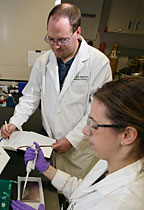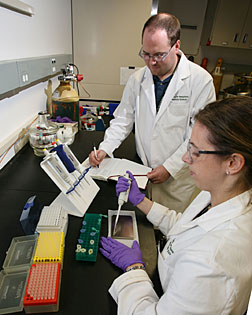| Research
|
|
|||||||||||||||||||||
|
Check out the joint Fermilab/SLAC publication symmetry.
|
A new kind of magnet for the LHC
Earlier this year members of Lawrence Berkeley National Laboratory's Accelerator and Fusion Research Division (AFRD) and their Brookhaven National Laboratory and Fermi National Accelerator Laboratory collaborators within DOE successfully tested a model superconducting magnet dubbed LRS01 at Brookhaven. The new magnet design is planned for the interaction regions of the Large Hadron Collider at CERN when the LHC is upgraded some years hence. Inside its long supporting structure, LRS01 uses niobium-tin "racetrack" windings instead of the niobium-titanium windings found in today's accelerator magnets (LRS stands for Long Racetrack Shell). At 3.6 meters LRS01 is the first niobium-tin model of its kind significantly longer than one meter in length, approaching the length of the real magnets that will be needed for the LHC upgrade. Superconducting magnets must be trained to reach their optimum field strengths through repeated deliberate quenchings, or losses of superconductivity. During the test, the training of LRS01 started above 80 percent of the magnet's estimated maximum current density, and after only five quenchings the current had reached 91 percent of its target. This corresponds to a peak magnetic field of 11 tesla, surpassing the 10-tesla limitation of accelerator-type coils based on niobium-titanium technology. These and other results are evidence, says Berkeley Lab's Paolo Ferracin, that "the LRS01 magnet is providing key information for the fabrication of long niobium-tin coils and the optimization of shell-based support structures." LRS01's racetrack coils were fabricated at Brookhaven and the supporting shell structure was designed and built by the 18-member Superconducting Magnet Group in Berkeley Lab's AFRD. Ferracin, who led the AFRD effort, emphasizes "the successful partnership between the labs" and calls the tests "a major milestone in the development of superconducting magnets for the Large Hadron Collider's Interaction Regions, beyond the current design." Berkeley Lab, Brookhaven, and Fermilab are partners in the U.S. LHC Accelerator Research Program.Submitted by DOE's
Lawrence Berkeley |



